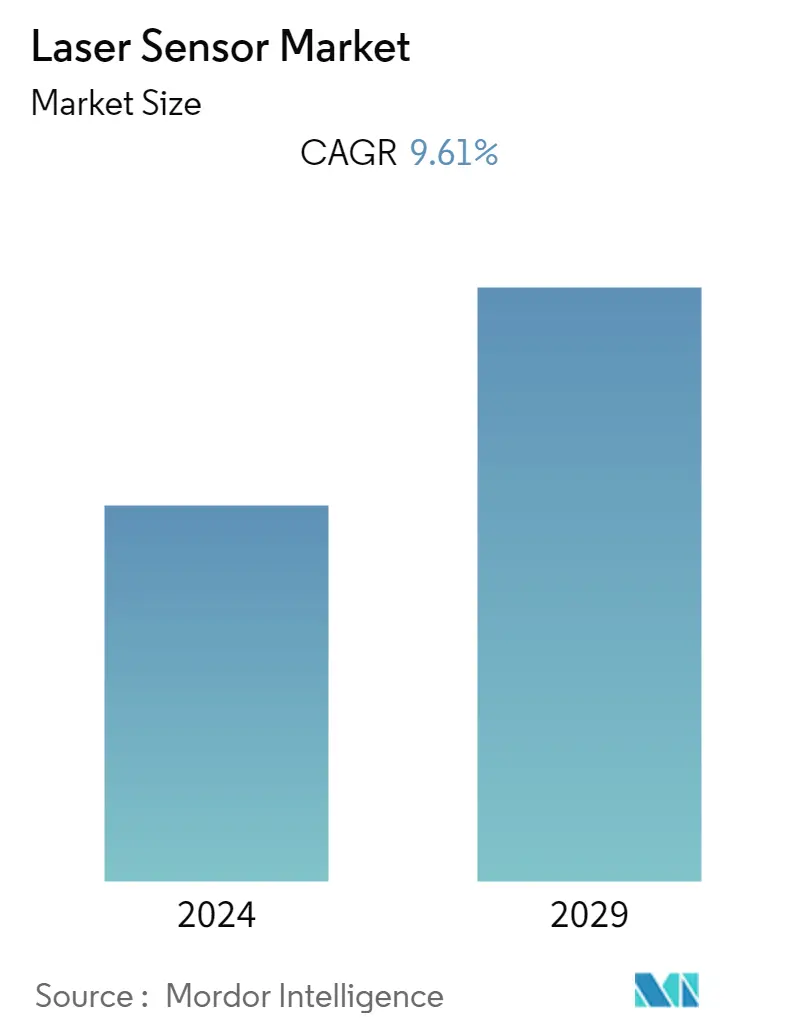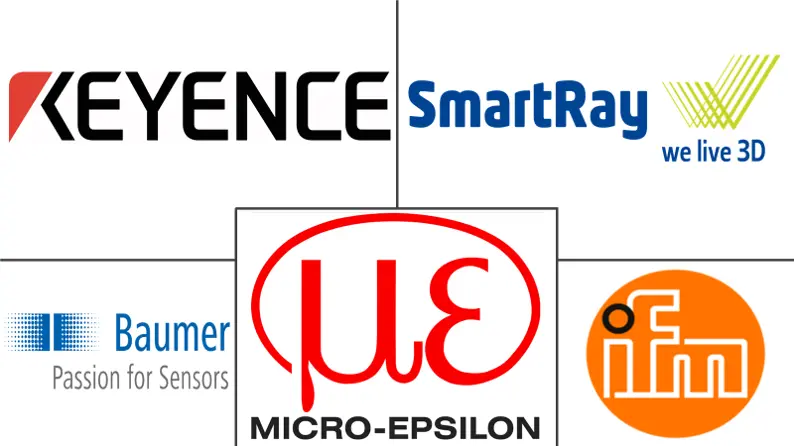Market Size of Laser Sensor Industry

| Study Period | 2019 - 2029 |
| Base Year For Estimation | 2023 |
| CAGR | 9.61 % |
| Fastest Growing Market | Asia Pacific |
| Largest Market | Asia Pacific |
| Market Concentration | Medium |
Major Players
*Disclaimer: Major Players sorted in no particular order |
Laser Sensor Market Analysis
The global laser sensors market was valued at USD 989.45 million in 2020, and it is expected to reach a value of USD 1,699.82 million by 2026 registering a CAGR of 9.61% during the forecast period (2021 - 2026). The emerging semiconductor laser technologies are significantly revolutionizing the industrial automation process. IIoT is expected to become a game-changer for the modern factory providing a new trend to the market. The applications of an industrialized inspection need detection of the presence and absence of an object. This can be solved by using a laser sensor to address quality control tasks.
- Laser distance sensors are designed for non-contact distance measurements: laser gauges for measuring ranges up to 10 meters, laser distance sensors for up to 3,000m. These sensors are generally utilized for positioning and type classification in machine building and handling equipment.
- Moreover, in Feb 2020, VocalZoom (VZ), a manufacturer and provider of vibration sensors for industry 4.0, announced the launch of its autonomous laser sensors for the IIoT. It combines contactless, high-resolution vibration sensor technology with built-in data processing and wireless communications. It offers low-cost and fast deployment of a wide range of positioning and monitoring applications for IIoT environments.
- Further, attaining stable and accurate measurements is essential to ensure reliable product values and error-free production. The laser sensor can be used on reflective surfaces, numerous materials, and colors. These sensors are incorporated with rough, independent housing, a linear imager, a pinpoint laser emitter.
- According to Emerson, the projected growth of the global factory automation market is expected to increase from 3% in 2019 to 3.5% by 2021, which significantly holds the market demand. Further, the use of laser sensor technology innovation in the maritime and offshore industry is expected to be a future trend. Primarily a laser-based navigational aid, LADAR (Laser Detection and Ranging), combines long-distance object detection with high -accuracy measurement, giving users a full 2D/ 3D/4 D ( 3 D plus time) perspective for optimal maritime awareness.
- Further, players are innovating new devices and technology innovation, providing the integration of laser sensors, which are attributing to market growth. For instance, in April 2020, Xiaomi unveiled the company's new smart Internet of Things (IoT) home appliance Mi Vacuum -Mop P series in India. The Mi Vacuum is incorporated into twelve different multi-directional sensors and a dedicated Laser Distance Sensor (LDS) navigation system such that it can be used to scan complex environments accurately and avoid obstacles during the cleaning process.
- The COVID -19 outbreak in China is disrupting the global tech sector, especially hardware, electronic manufacturing services providers, and semiconductor companies, as operations in the world's largest tech manufacturing hub are threatened. Also, for the COVID -19 situation, researchers have been developing a laser sensor that can pick up diseases at the earliest point of infection from saliva or nasal swab in minutes. They say the non -invasive optical biosensor demonstrator will pick up COVID-19 in people as soon as it is present in the body. The researchers already created six working laboratory demonstrators for other applications and said that the technology still needs further development and testing but could be available within 2020. This significantly helps the market growth in this sector.
Laser Sensor Industry Segmentation
A laser sensor is basically a measurement value recorder that is working with the laser technology and turning the measured physical value into an analog electrical signal. The market study comprises hardware and software and service, and the vendors provide solutions to various end-users, such as electronics manufacturing, aviation, construction, automotive, and other end users.
| Component | |
| Hardware and Software | |
| Services |
| End-user Industry | |
| Electronics Manufacturing | |
| Aviation | |
| Construction | |
| Automotive | |
| Other End-user Industries |
| Geography | |||||||
| |||||||
| |||||||
| |||||||
| Rest of the World |
Laser Sensor Market Size Summary
The laser sensors market is experiencing significant growth, driven by advancements in semiconductor laser technologies and the integration of Industrial Internet of Things (IIoT) solutions. These technologies are transforming industrial automation processes, enhancing quality control through non-contact distance measurements and object detection. The market is witnessing increased adoption across various sectors, including automotive, maritime, and consumer electronics, where laser sensors are utilized for precise measurements and navigation. Innovations such as autonomous laser sensors and laser-based navigational aids are further propelling market expansion, with companies like VocalZoom and Xiaomi leading the charge in developing advanced sensor technologies for IIoT and smart home applications.
The market landscape is characterized by intense competition, with numerous vendors and non-laser companies entering to capitalize on the opportunities presented by laser sensor technologies. Key players are expanding their product portfolios through acquisitions and new product launches, such as SmartRay's ECCO sensor and Micro-Epsilon's Blue Laser version. The North American region remains a prominent market due to its early adoption of new technologies and strong demand from defense and consumer electronics sectors. Additionally, government initiatives promoting advanced driver-assistance systems (ADAS) and autonomous vehicles are expected to drive further growth in the laser sensor market, with significant developments in LiDAR technology and its applications in self-driving vehicles.
Laser Sensor Market Size - Table of Contents
-
1. MARKET DYNAMICS
-
1.1 Market Overview
-
1.2 Market Drivers
-
1.2.1 Increasing Adoption of Industry 4.0 and Smart Manufacturing Practices
-
1.2.2 Reduction of Price Leading to Large Scale Application
-
-
1.3 Market Restraints
-
1.3.1 High Requirement of Power and Energy Density for Measuring Smaller Beams
-
-
1.4 Industry Value Chain Analysis
-
1.5 Industry Attractiveness - Porter's Five Force Analysis
-
1.5.1 Threat of New Entrants
-
1.5.2 Bargaining Power of Buyers
-
1.5.3 Bargaining Power of Suppliers
-
1.5.4 Threat of Substitute Products
-
1.5.5 Intensity of Competitive Rivalry
-
-
1.6 Impact of COVID-19 on the Industry
-
-
2. MARKET SEGMENTATION
-
2.1 Component
-
2.1.1 Hardware and Software
-
2.1.2 Services
-
-
2.2 End-user Industry
-
2.2.1 Electronics Manufacturing
-
2.2.2 Aviation
-
2.2.3 Construction
-
2.2.4 Automotive
-
2.2.5 Other End-user Industries
-
-
2.3 Geography
-
2.3.1 North America
-
2.3.1.1 United States
-
2.3.1.2 Canada
-
-
2.3.2 Europe
-
2.3.2.1 United Kingdom
-
2.3.2.2 Germany
-
2.3.2.3 France
-
2.3.2.4 Rest of Europe
-
-
2.3.3 Asia-Pacific
-
2.3.3.1 China
-
2.3.3.2 Japan
-
2.3.3.3 India
-
2.3.3.4 South Korea
-
2.3.3.5 Rest of Asia-Pacific
-
-
2.3.4 Rest of the World
-
-
Laser Sensor Market Size FAQs
What is the current Laser Sensor Market size?
The Laser Sensor Market is projected to register a CAGR of 9.61% during the forecast period (2024-2029)
Who are the key players in Laser Sensor Market?
Keyence Corporation, Baumer Electric AG, SmartRay GmbH, Micro-Epsilon Messtechnik GmbH & Co. KG and IFM Electronics GmbH are the major companies operating in the Laser Sensor Market.

